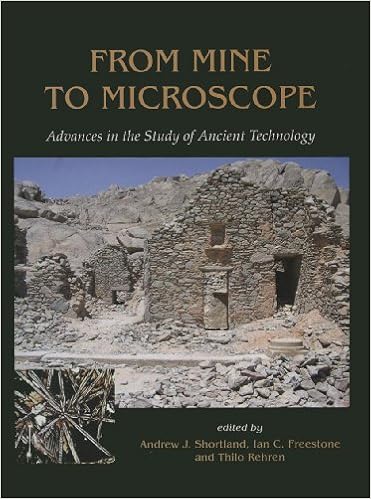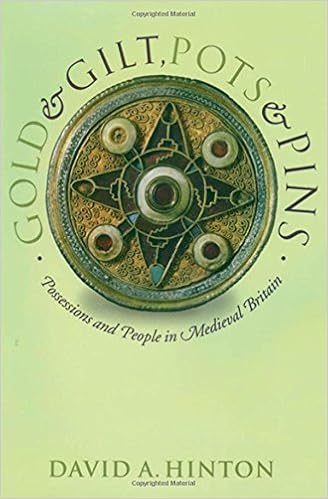These twenty papers devoted to Mike Tite concentration upon the translation of old artefacts and applied sciences, rather in the course of the program of fabrics research. tools from the human eye to mass spectrometry supply insights right into a diversity of applied sciences starting from classical alum extraction to Bronze Age wall portray, and canopy fabrics as various as niello, flint, bronze, glass and ceramic. Ranging chronologically from the Neolithic via to the medieval interval, and geographically from Britain to China, those case reviews offer an extraordinary evaluation in order to be of worth to scholars, lecturers and researchers with an curiosity in early fabric culture.
Quick preview of From Mine to Microscope: Advances in the Study of Ancient Technology PDF
Best Archaeology books
Set within the middle of the yankee jungle and that includes Declan Carberry, the not-so good-looking hero of Day of Wrath, this page-turner oozes pleasure, exotica and formulation One suspense. Archaeologist Leo is on a dig. yet this is often no traditional task. he is deep within the middle of the Mexican jungle uncovering one other centuries-old Mayan urban.
Chris Stringer's bestselling "The foundation of our Species" tackles the massive questions within the ongoing debate concerning the beginnings of human lifestyles on the earth. Do all people originate from Africa? How did we unfold around the globe? Are we become independent from Neanderthals, or perform a little people even have their genes?
The Vikings: A Very Short Introduction (Very Short Introductions)
The Viking attractiveness is one among bloodthirsty seafaring warriors, again and again plundering the British Isles and the North Atlantic through the early heart a while. but Vikings have been additionally investors, settlers, and farmers, with a fancy inventive and linguistic tradition, whose growth abroad led them to go the Atlantic for the 1st time in eu background.
During this hugely illustrated e-book, David Hinton seems to be at what possessions intended to humans at each point of society in Britain within the heart a long time, from complex gold jewelry to clay pots, and offers a desirable window into the society of the center a long time. Gold and Gilt, Pots and Pins is set issues worn and utilized in Britain in the course of the center a while, from the good treasure hoards that mark the top of the Roman Empire to the recent expressions of principles promoted through the Renaissance and Reformation.
- Artifacts from Ancient Rome
- Evolution and Prehistory: The Human Challenge (9th Edition)
- The Writing of Weddings in Middle-Period China: Text and Ritual Practice in the Eighth through Fourteenth Centuries (SUNY series in Chinese Philosophy and Culture)
- The Classical Archaeology of Greece: Experiences of the Discipline (Experiences of Archaeology)
- Medieval Archaeology: An Encyclopedia (Routledge Encyclopedias of the Middle Ages)
- The Doomsday Prophecy
Additional info for From Mine to Microscope: Advances in the Study of Ancient Technology
Broad dendritic formations of cuprite emerged because the most vital characteristic of the glass. Figures 1(a) and (b) and (c) exhibit the microstructure of the dendrites and glass. the 2 positive aspects noticeable in Fig. 1(a) should have been sections during the similar dendrite, as they have been within the comparable crystallographic orientation. determine 1(b) illustrates a part of a tremendous dendrite, displaying the relatively average morphology of the rounded ends of the branches. Figures 1(c) is the sector axis electron diffraction development such as Fig. 1(a). The cuprite conveniently decomposes in the course of remark through TEM. The incipient alteration is clear within the photos of Fig. 1(a) and (b). After exposures to the beam of some seconds the alteration factors the electron diffraction styles to improve reflections which are indicative of copper. firstly the electron harm ended in a few confusion concerning the nature of the dendrite-like growths and different debris heavily linked to them. We resolved this challenge in numerous methods. One was once to check specimens of cuprite mineral within the TEM, in order that we have been larger capable of know the features of cuprite, regardless of its tendency to change to copper in the course of electron irradiation. We labored totally on cuprite pattern no. BM72066 from the average heritage Museum, London. effects from EDX microanalysis have been a bit equivocal as the dendrites of moment part and person crystals have been frequently nonetheless in part embedded within the matrix glass after ion-milling. thus, approximately all microanalysis effects from AEM have a spectral contribution from the encircling glass and one can't be yes of the resource of the oxygen sign within the spectrum. We accordingly conducted microanalyses utilizing XPS, AES and ToF-SIMS, utilizing gear that enabled glass to be sputtered away to reveal dendrites. determine 1: (a) and (b) are vivid box TEM photos of elements of cuprite dendrites within the glass from Nimrud. a few electron harm is clear. Fig. 1 (c) is a specific region diffraction trend from one of many dendrite palms noticeable in Fig. 1(a). determine 2: (a) An Auger electron map for copper (568 eV, L3M45M45 line), displaying that the dendrites in Nimrud glass are wealthy in steel. including corresponding electron maps for oxygen (978 eV, KL23L23 line), which exhibit that the dendrites comprise oxygen, even if proportionately lower than the glass, e. g. Fig. (b), Auger mapping indicated that the dendrites are mostly an oxide of copper. The XPS effects express that the Nimrud glass comprises the weather Mg, F, P, Cl, okay, Ca, Cu, and Zn, as well as Na, Pb, Si and O. there's additionally a sign of the potential presence of As. The overlapping of peaks is an issue, and a few peaks couldn't be pointed out (e. g. one taking place at 555 eV). Auger-electron mapping of copper, Fig. 2(a), and oxygen, Fig. 2(b), means that either components are found in the dendritic growths in the glass. The curve-fitting of the XPS strains for copper point out that Cu is found in either steel shape (932. eight eV experimentally, cf.





